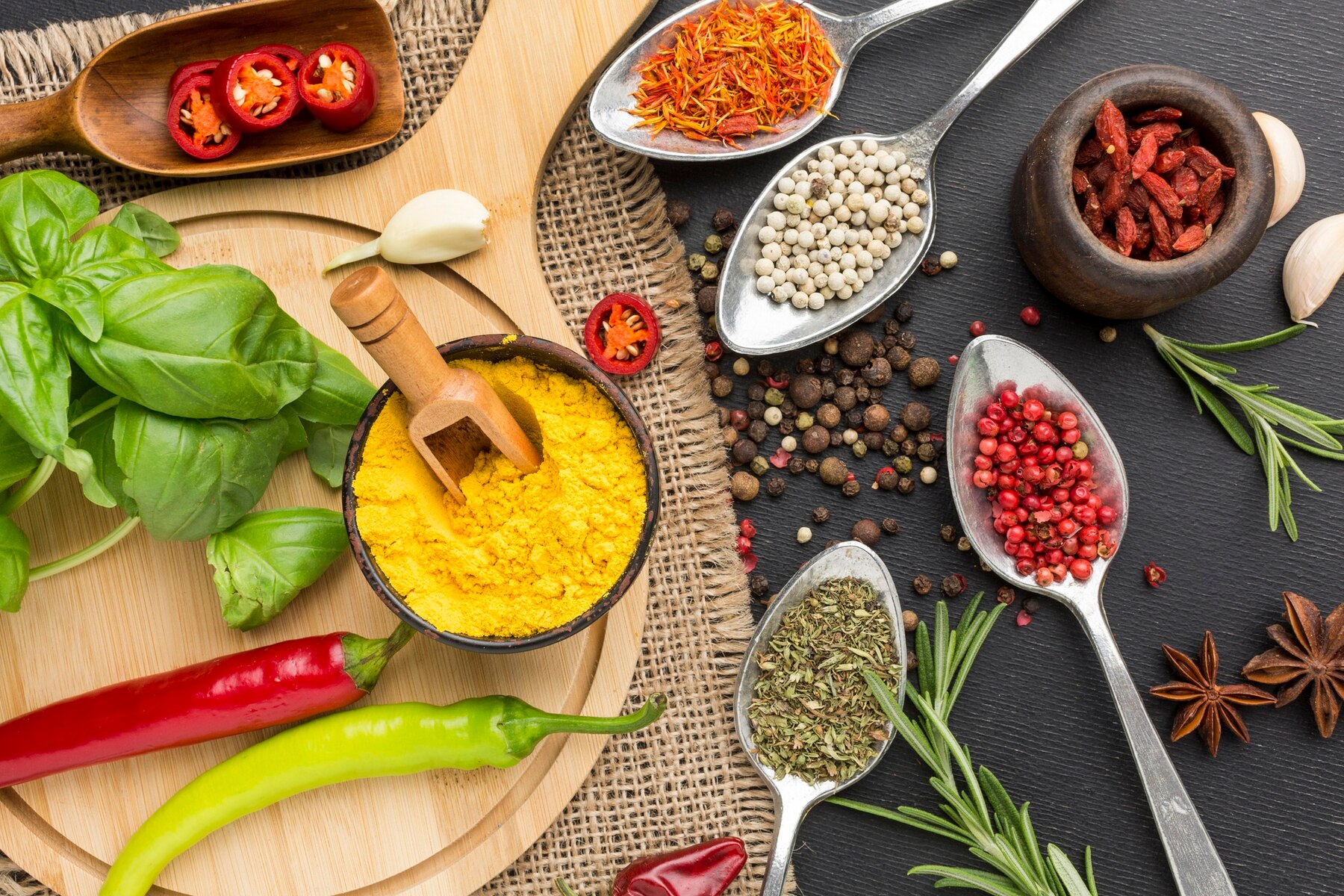Thai cuisine is renowned for its intricate balance of flavors and vibrant dishes that tantalize the senses. Central to this culinary artistry are the unique herbs and spices that give Thai food its distinctive taste. Each herb and spice used in Thai cooking not only enhances the flavor but also brings health benefits. Let’s explore some of the most essential herbs and spices that define Thai cuisine.
Read More on Kung Pao Chicken Recipe
1. Lemongrass (Cymbopogon citratus)
Lemongrass is a fragrant herb that adds a citrusy flavor to many Thai dishes. Its subtle lemony scent is unmistakable and can elevate soups, curries, and stir-fries.
- Uses: It is commonly used in Tom Yum Soup, Tom Kha Gai, and various curries.
- Benefits: Lemongrass has antibacterial, antifungal, and anti-inflammatory properties. It aids in digestion, helps in detoxifying the body, and can alleviate stress and insomnia.
2. Galangal (Alpinia galanga)
Often confused with ginger, galangal has a sharper, more peppery flavor. It’s a key ingredient in many Thai dishes, providing a unique pungency.
- Uses: Essential in Tom Kha Gai, various curry pastes, and soups.
- Benefits: Galangal is known for its anti-inflammatory and antioxidant properties. It aids in digestion, boosts immunity, and can help alleviate nausea.
3. Kaffir Lime Leaves (Citrus hystrix)
These glossy, dark green leaves have a distinct aroma and flavor that is both floral and citrusy. They add a unique zest to Thai dishes.
- Uses: Commonly used in soups like Tom Yum, curries, and stir-fries.
- Benefits: Kaffir lime leaves aid in digestion, improve oral health, and have anti-inflammatory properties. They also act as a natural insect repellent.
4. Thai Basil (Ocimum basilicum var. thyrsiflora)
Thai basil, with its anise-like flavor and spicy undertone, is a staple in Thai cuisine. It differs from sweet basil in its aroma and taste.
- Uses: Often used in stir-fries, curries like Green Curry, and salads.
- Benefits: Thai basil has antimicrobial properties, supports digestion, and is rich in antioxidants. It also promotes cardiovascular health.
5. Bird’s Eye Chilies (Capsicum annuum)
These small, fiery chilies pack a powerful punch and are integral to adding heat to Thai dishes. They are known for their intense spiciness.
- Uses: Used in spicy salads, curries, and sauces like Nam Prik.
- Benefits: Bird’s Eye Chilies boost metabolism, are rich in vitamins A and C, and have pain-relieving properties due to capsaicin.
6. Coriander (Coriandrum sativum)
Both coriander leaves (cilantro) and seeds are used in Thai cooking, adding a fresh, citrusy flavor to dishes.
- Uses: Commonly used in salads, soups, and as a garnish for various dishes.
- Benefits: Coriander aids in digestion, lowers blood sugar levels, and has antibacterial properties. It also helps in detoxifying the body.
7. Turmeric (Curcuma longa)
Turmeric, with its bright yellow hue and earthy flavor, is often used in Thai curries and soups. Its mild, slightly peppery taste enhances many dishes.
- Uses: Used in curries, soups, and marinades.
- Benefits: Turmeric is known for its anti-inflammatory and antioxidant properties. It supports joint health, improves digestion, and boosts the immune system.
8. Garlic (Allium sativum)
Garlic is a foundational ingredient in Thai cuisine, providing a robust and savory flavor that compliments other spices and herbs.
- Uses: Used in stir-fries, curries, sauces, and pastes.
- Benefits: Garlic has antimicrobial and antioxidant properties. It supports heart health, boosts the immune system, and has anti-inflammatory effects.
9. Shallots (Allium cepa var. aggregated)
Shallots are often used in Thai cooking to add a sweet, mild onion flavor to dishes. They are more delicate and nuanced compared to regular onions.
- Uses: Used in salads, soups, and curry pastes.
- Benefits: Shallots are rich in antioxidants, support heart health, and have anti-inflammatory properties. They also promote digestive health.
10. Cumin (Cuminum cyminum)
Cumin seeds, with their warm, earthy flavor, are used in small quantities to add depth to Thai dishes, particularly in curry pastes.
- Uses: Used in curry pastes and spice blends.
- Benefits: Cumin aids in digestion, boosts the immune system, and has antioxidant properties. It also helps in managing blood sugar levels.
The Final Word:
Thai Cuisine is a harmonious blend of flavors, with each herb and spice playing a crucial role in creating the perfect balance. These unique ingredients not only define the taste of Thai dishes but also offer numerous health benefits. By incorporating these herbs and spices into your cooking, you can bring the vibrant and aromatic world of Thai cuisine to your kitchen.
Unlock the secrets of Solanas Authentic Thai flavors! Explore the unique herbs and spices that create Thailand’s culinary magic. Ready to recreate these dishes at home?
Discover More on Our Catering Services
FAQs:
1. Can I use regular basil instead of Thai basil in Thai recipes?
While regular basil can be used as a substitute, it has a different flavor profile. Thai basil has a distinct anise-like flavor that is essential for authentic Thai dishes.
2. How can I reduce the spiciness of a Thai dish?
You can reduce the number of Bird’s Eye Chilies or remove their seeds to lower the heat. Additionally, adding more coconut milk or sugar can help balance the spiciness.
3. Where can I find these unique herbs and spices?
Many of these herbs and spices are available at Asian grocery stores, specialty spice shops, or online. Some, like lemongrass and Thai basil, can also be grown at home.
4. Can I substitute galangal with ginger in Thai recipes?
While galangal and ginger are related, they have different flavors. Ginger can be used as a substitute, but it will change the flavor profile of the dish slightly.
5. What is the best way to store these herbs and spices?
Fresh herbs like lemongrass, Thai basil, and kaffir lime leaves should be stored in the refrigerator, wrapped in a damp paper towel. Dried spices like cumin and turmeric should be stored in a cool, dark place in airtight containers.
